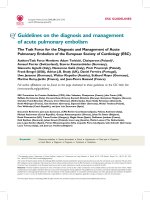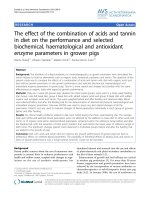Effect of encapsulated amylase enzyme on the performance and digestibility of energy in broilers
Bạn đang xem bản rút gọn của tài liệu. Xem và tải ngay bản đầy đủ của tài liệu tại đây (176.8 KB, 7 trang )
Int.J.Curr.Microbiol.App.Sci (2017) 6(3): 2098-2104
International Journal of Current Microbiology and Applied Sciences
ISSN: 2319-7706 Volume 6 Number 3 (2017) pp. 2098-2104
Journal homepage:
Original Research Article
/>
Effect of Encapsulated Amylase Enzyme on the Performance and
Digestibility of Energy in Broilers
R. Purshotham Naik1*, A. Rajashekher Reddy1, K. Kondal Reddy2, and J. Jyothi3
1
Department of Poultry Science, College of Veterinary Science Rajendranagar,
Hyderabad, 30, India
2
Department of Livestock Products Technology, CVSc- Rajendranagar, Hyderabad-30, India
3
Department of Veterinary Medicine, C.V.Sc, Korutla, India
*Corresponding author
ABSTRACT
Keywords
Amylase,
Encapsulation,
Digestibility, FCR.
Article Info
Accepted:
20 February 2017
Available Online:
10 March 2017
Enzymes are thermo-labile and they may lose activity during pelletization of feed.
Encapsulation/ coating of enzyme is important for the stability of feed enzymes. Effect of
feeding encapsulated amylase enzyme in corn soy pelleted diets on the performance of
broilers was studied. Amylase enzyme were encapsulated with sodium alginate and
included in diets at 2000 IU/kg. Two hundred day old broiler chicks were randomly
distributed into four treatments, with 10 replicates of 5 birds in each replicate. Two diets –
control and basal diets were formulated for starter and finisher. Basal diet (BD) was
reduced by 115k.cal ME compared to control diet. Addition of uncoated and coated
amylase enzyme to basal diets did not show significant (P<0.05) improvement in body
weight gain and feed intake, but there was significant improvement in FCR and
digestibility of energy for uncoated and coated amylase enzyme compared to control. Thus
it can be concluded that addition of amylase enzyme has resulted in improved performance
through better FCR, digestibility and reduced abdominal fat.
Introduction
Feeding of poultry is a major component that
decides the profit. Corn and soyabean meal
are the major ingredients used in the
preparation of poultry feed. Pelleting is
associated with positive effects by improving
feed efficiency and growth performance of
broilers. These improvements are attributed to
decreased feed wastage, higher bulky, nutrient
density, no selective feeding, decreased feed
segregation, thermal modification of starch
and protein, improved palatability and
inactivation of enzyme inhibitor (Piesker,
2006). Exogenous enzyme play a key role in
digestive process, but these added must be
active
under
physiological
condition
prevailing in the animal digestive tract in
order to realize their benefits. Activity of
enzymes is reduced /lost during pellet
processing involving temperature and steam
(Jensen, 2000). The combination of heat and
humidity may cause a severe inactivation of
enzymes thus to overcome this problem
coating
of
enzyme
with
a
2098
Int.J.Curr.Microbiol.App.Sci (2017) 6(3): 2098-2104
barrier/encapsulation is one approach to
prevent contact of the enzyme with steam,
moisture and harsh condition during pelleting.
The coated/encapsulated may survive the
pelleting process well. In view of the above,
present study was conducted to evaluate the
supplementation of encapsulated amylase
enzyme effect on the performance of broilers
(FCR, Body weight gain, Feed intake), live
ability, carcass parameters, digestibility, and
serum protein.
Materials and Methods
Two hundred day old commercial broiler
chicks were randomly distributed into 4
treatments with 10 replicates of 5 birds in
each replicate, which were reared for a period
of 6 weeks under uniform managemental
conditions.
On day 1, chicks were wing banded and
housed in wire-floored stainless battery
brooders. Birds were immunized for Marek’s
disease at hatchery, New Castle disease (ND)
at 7th day and 21stday of age with Lasota
vaccine and infectious bursal disease at
14thday of age with Georgia strain vaccine.
A corn soya starter (0-3wks) and finisher (46wks) pelleted diets were formulated (NRC
1994) for four treatments i.e T1-Control diet,
T2-Basal diet (BD) (with 115kcal less ME
compared to control diet), T3- BD+ uncoated
amylase enzyme and T4-BD+ coated amylase
enzyme (Table 1,2), amylase enzyme was
added at 2000 IU/kg feed.
All the treatments were offered ad-libitum
feed and water for 1-42 days.
Weekly body weights, feed intake and weight
of feed residue was recorded to calculate the
weekly body weight gain and FCR.
Encapsulation
Technique)
of
enzymes
(Extrusion
Coating of enzymes was done by using
alginate standard method (Krasaekoopt et
al.,2003) amylase enzymes was added into a
hydrocolloid solution (alginate) and then the
cell suspension was extruded through a
syringe needle to form droplets, which freefall into a setting bath containing hardening
solution CaCl2. Concentration of alginate was
1% to form a gel with 0.5M CaCl2. Uniform
size and shape beads were obtained with
alginate coat over enzymes for use in
experimental diets
Metabolic trial
A metabolic trial was conducted for three
days after 42 days of trial by keeping 2 birds
in each replicate. All the birds were fasted to
ensure emptying of gastrointestinal tract.
Weighed quantity of feed was offered for
three days. Litter trays were covered with
plastic sheets under each cage cells and were
replaced with new plastic sheet very next day.
Faecal samples were collected daily carefully
by separating feathers, scales and traces of
feed. All the faecal samples were oven dried
at 60oC for 24 hrs and weighed to record the
faecal output on dry matter basis.
Representative samples of feed and left over
feed were collected and dried at 100±5oC for
8-10 hrs to estimate the dry matter intake.
Analysis of crude protein and gross energy of
dried excreta as carried as per AOAC (2005).
Slaughter and serum parameters
At the end of experiment 2 birds per replicate
were slaughtered for carcass parameters like
dressing percentage, heart, gizzard, liver
weighs and abdominal fat weight. Blood
samples were collected in clean sterilized
glass tubes for serum collection and the serum
was stored in eppendorf tubes at – 200 C for
2099
Int.J.Curr.Microbiol.App.Sci (2017) 6(3): 2098-2104
estimation of biochemical constituents i.e.,
total protein (Reinhold, 1953).
Statistical analysis
The data were subjected to statistical analysis
by applying one way ANOVA as per
procedures of Snedecor and Cochran (1980).
The differences between the means were
tested by significance using Duncan’s
multiple range test (Duncan, 1955).
Results and Discussion
Body weight gain
Supplementation of coated amylase enzyme
preparation in corn soya low energy basal diet
resulted (P<0.05) significant increase in body
weight gain by 4.1% during 0-3wks for
coated amylase and numerical increase in
body weight gain by 3.1% is observed in
supplementation of uncoated amylase enzyme
when compared to basal diet. During 0-6 wks
period no significant improvement was
observed in enzyme supplemented groups
when compared to low energy basal diets, and
this is in agreement with parkany-gyarfas
(1975), who found a 3.6% improvement in
body weight gain and 4.0% improvement in
feed utilization in male turkey when corn
soybean meal diets was supplemented with αamylase and similar results were observed by
Ritz et al, (1995). The improvement in body
weight gain during 0-3wks might be due to
beneficial effect of supplemental exogenous
enzyme as the production of endogenous
enzymes during early chick stage is
inadequate due to poor development of
digestive system and which was reported to
mature with increase in age of the bird.
(Olukosi et al, 2007).
Feed intake and FCR
Supplementation of enzyme resulted no
significant increase in feed intake during 03wk, 4-6wk and 0-6wks period when
compared to low energy basal diet and this
was in agreement with cowienson and
Ravindran (2008) who reported that
supplementation of enzyme in corn soya diet
resulted no improvement in feed intake in
broilers. Supplementation of enzyme resulted
in improvement of FCR. Coated amylase
showed better when compared to control and
basal diets during 4-6wks and 0-6wks (Table3). Significant improvement in FCR for
coated (1.723) and uncoated (1.731) when
compared to control (1.798) and low energy
basal diet (1.772) during 0-6wks period and
this was in agreement with srinath et al
(2012). Improvement of FCR in enzyme
supplemented diets might be due to better
digestibility of nutrients. The digestibility of
starch with amylase enzyme may explain the
improvement in FCR in our work. This was
supported by Ritz et al (1995) who reported
that amylase enzyme supplementation
increased the length of villi with in jejunal
and ileal section in 3wk old turkey poult fed
corn soya-bean meal diet. The increase in area
suggested by increase in villus length and that
might have enhanced the nutrient absorption
and there by improved the nutrient
digestibility.
Table.1 Treatment groups and diets
Treatment groups
T1
T2
T3
T4
Treatment diets
Control
Basal diet (115kcal less ME of control)
Basal + uncoated amylase
Basal + coated amylase
2100
Int.J.Curr.Microbiol.App.Sci (2017) 6(3): 2098-2104
Table.2 Ingredient (g/kg) and nutrient composition (% dry matter) of basal diet fed to broilers
Ingredients
Starter(0-3 wks)
Finisher(4-6 wks)
Control diet
Basal diet
Control diet
Basal diet
Maize
554.08
582.67
628.33
655.47
Soya bean meal
383.04
377.45
303.82
298.75
DORB
0.00
0.80
0
0
Salt
3.99
3.99
4.0
4.0
Dicalcium phosphate
19.55
19.42
17.12
17.03
Shell grit
4.52
4.66
4.48
4.57
DL-Methionine
2.66
2.66
2.21
2.19
1
AB2D3K
0.13
0.27
0.2
0.2
B complex2
0.13
0.13
0.15
0.15
Choline chloride
0.93
1.06
1.0
1.0
Toxin Binder
2.00
2.00
2.0
2.0
Trace mineral mixture3
0.93
1.06
1.0
1.0
Antibiotic(chlortetracycline)
0.53
0.53
0.5
0.5
Cocciodiostat
0.53
0.53
0.5
0.5
L-Lysine
0.53
0.67
0.99
1.08
Vegetable oil
23.81
0.00
33.7
11.56
Nutrient composition (calculated)*
M.E (kcal/kg)
2900
2785
3100
2985
Protein %
22
22
19
19
Calcium %
0.8
0.8
0.8
0.8
Available phosphorus %
0.45
0.45
0.4
0.4
Lysine %
1.25
1.25
1.097
1.097
Methionine %
0.56
0.56
0.51
0.51
1 Vitamin premix provided per kg diet: Vitamin A, 20000IU; Vitamin D 3, 3000IU; Vitamin E, 10mg; Vitamin K, 2mg;
2 Riboflavin, 25mg; VitaminB1,1mg; Vitamin B6, 2mg; Vitamin B12, 40mcg and Niacin, 15 mg.
3 Trace mineral premix provided per kg diet: Cu: 8 mg, Mn: 60 mg, Fe: 80 mg.
*
Calculated values.
Table.3 Effect of uncoated and coated amylase enzyme on body weight gain, feed intake, FCR
0-3 wks
B.wt
gain
T1-Control
T2-Basal diet (BD)
T3-BD+uncoated
amylase
T4-BD+coated
amylase
SEM
p-value
Feed
intake
4-6wks
0-6 wks
FCR
B.wt
gain
Feed
intake
FCR
B.wt
gain
Feed
intake
FCR
1.575a
1.616b
1.563a
1276a
1201b
1228ab
2431a
2221b
2229b
1.906c
1.850b
1.816ab
1894a
1800b
1846ab
3405a
3189b
3194b
1.798b
1.772b
1.731a
623.7a
993.2 1.593ab
1231ab
2203b
1.790a
1854ab
3196b
1.723a
4.064
0.154
6.612
0.463
9.877
0.051
22.376
0.000
0.010
0.000
11.417
0.029
24.090
0.001
0.007
0.000
617.7
973.1
b
599.1
968.4
ab
617.9
965.8
0.006
0.006
Values bearing different superscripts within a column are significantly (P<0.05) different
2101
Int.J.Curr.Microbiol.App.Sci (2017) 6(3): 2098-2104
Table.4 Effect of uncoated and coated amylase enzyme on dressing yield,
giblet weight and fat weight (percentage)
Diets
Dressing yield %
Heart wt %
Gizzard wt %
1.952
1.869
Liver
%
1.700
1.704
Fat wt
%
1.739a
1.550b
T1-Control
T2-Basal diet (BD)
71.91
71.47
0.438
0.409
T3-BD+uncoated amylase
72.38
0.438
1.985
1.744
1.267c
T4-BD+coated amylase
71.98
0.465
1.819
1.792
1.262c
SEM
p-value
0.1712
0.322
0.0106
0.344
0.0360
0.352
0.0291
0.664
0.0373
0.000
Values bearing different superscripts within a column are significantly (P<0.05) different
Table.5 Effect of uncoated and coated amylase enzyme on serum protein
Diets
Control
Basal diet
Basal +uncoated amylase
Basal +coated amylase
SEM
p-value
Serum protein (g/dl)
3.395
3.279
3.300
3.327
0.0249
1.028
Values bearing different superscripts within a column are significantly (P<0.05) different
Table.6 Effect of uncoated and coated amylase enzyme on digestibility of protein and Energy
Diet
Control
Basal diet
Basal +uncoated amylase
Basal +coated amylase
SEM
p-value
Digestibility %
Crude protein
63.63a
61.18b
61.12b
62.18b
0.300
0.003
Dry matter
66.47
65.21
66.92
67.57
0.423
0.255
Energy
64.10bc
63.53c
65.48ab
66.40a
0.368
0.013
Values bearing different superscripts within a column are significantly (P<0.05) different
Livability and carcass characteristics
Supplementation of uncoated and coated
amylase enzyme to basal diet did not show
significance difference on livability (Rao et
al, 2003) and dressing percentage in broilers
(Table 4) compared to control diet and basal
diet. But addition of both uncoated and coated
2102
Int.J.Curr.Microbiol.App.Sci (2017) 6(3): 2098-2104
amylase enzyme showed significant in
reduction in abdominal fat when compared to
basal and control and the results are in
agreement with Garipoglu et al (2006).
Abdominal fat is not only a loss, but also it
represents added expense for the effluent
treatment. Visceral organ weights (Liver,
heart, and gizzard) were un-affected in
present study with enzyme supplementation
and these results are in agreement with
Ramesh and chandrasekaran (2011) who
reported that there is no significant difference
in weights of liver, heart, and gizzard.
Serum protein
Addition of uncoated (3.300) and coated
amylase enzyme (3.327) to basal diet did
show a significant improvement in total
serum protein level (Table 5) compared to
low energy basal diet (3.279) and control
(3.395). Abudabos (2010) reported that
addition of enzymes to corn-soy based diets
showed a significant increase in serum total
protein when tomoko a commercial enzyme
supplement which contained acidic protease,
amylase, pectinase, glucoamylase and
cellulose. The improvement in total serum
protein might be due to presence of protease
in the product that might have increased the
serum protein and this way protease is
involved in the digestibility of protein and
increasing the total serum protein.
Digestibility of protein and energy
Supplementation of uncoated and coated
amylase enzyme to low energy basal diet
showed an improvement in energy
digestibility by 1.95% and 2.87% respectively
(Table 6). This improvement in digestibility
by adding exogenous enzyme might have
unlock the encapsulated starch molecules by
solubilizing the cell wall structure and
increasing accessibility to digestive enzymes,
thus further enhancing the nutrient availability
for growth as reported by Hesselman and
Aman (1986). Therefore, the significant
improvement in protein and GE digestibility
observed for broilers fed the corn soyabean
diets could result mainly from disruption of
the cell wall matrix of soyabean, leading to
the release of structural starch and protein (Yu
and Chung, 2004). Marsmann et al (1997)
also found that supplementation of soybeans
with protease and carbohydrase enzymes,
individually and in combination improved CP
digestion and that the carbohydrase improved
the non-starch polysaccharide digestibility of
soybean meal. They suggested that the
carbohydrase that they have used also
exhibited protease activity, supporting the
observation by Pack et al (1998).
From the present study it can be concluded
that amylase enzyme supplementation has
resulted in improved performance through
better FCR and digestibility. Alginate process
of coating needs to be further investigated for
thermal stability and appropriate release of
enzymes in the digestive tract.
References
Abudabos, A. 2010. Enzyme supplementation
of corn-soybean meal diets improves
performance
in
broiler
chicken. International Journal of Poultry
Science, 9(3), 292-297.
AOAC. 2005. Official Methods of Analysis of
Association of official Analytical chemist
18th Edition (Virginia, USA, Association of
official Analytical chemists).
Cowieson A J and Ravindran V. 2008. Effects
of exogenous enzymes in maize-based
diets varying in nutrient density for young
broilers:
growth
performance
and
digestibility of energy, minerals and amino
acids. British Poultry Science 49:37-44
Duncan D B. 1955. Multiple ‘F’ test,
Biometrics 1: 142.
Garipoglu, A. V., Saricicek, B. Z., & Kilic, U.
(2006). Effects of the commercial enzyme
2103
Int.J.Curr.Microbiol.App.Sci (2017) 6(3): 2098-2104
supplementation to the rations on broiler
performance. Asian
J.
Anim.
Vet.
Adv, 1(1), 42-48.
Hesselman, K., & Åman, P. (1986). The effect
of β-glucanase on the utilization of starch
and nitrogen by broiler chickens fed on
barley of low-or high-viscosity. Animal
Feed Science and Technology, 15(2), 8393.
Jensen, L. S. (2000). Influence of pelleting on
the nutritional needs of poultry. AsianAustralasian
Journal
of
Animal
Sciences, 13(Special iss.), 35-46.
Krasaekoopt W, Bhandari B and Deeth H. 2003.
Evaluation of encapsulation techniques of
probiotics for yoghurt. Int Dairy J 13:3-13.
Marsman G J, Gruppen H, Vander poul A F,
Kwakkel R P, Verstegen M W and
Voragen A G. 1997. The effect of thermal
processing and enzyme treatments of
soybean meal on growth performance, ileal
nutrient digestibilities, and characteristics
in broiler chicks. Poultry Science 76: 864872.
National Research Council (1994) Nutrient
requirements of poultry, 9th edition,
National Academy Press, Washington.
Olukosi, O. A., Cowieson, A. J., & Adeola, O.
(2007). Age-related influence of a cocktail
of xylanase, amylase, and protease or
phytase individually or in combination in
broilers. Poultry Science, 86(1), 77-86.
Pack, M., Bedford, M., & Wyatt, C. (1998).
Feed enzymes may improve corn, sorghum
diets. Feedstuffs, 70(5), 18-19.
Peisker, M. (2006). Feed processing—Impacts
on nutritive value and hygienic status in
broiler feeds. In Proceedings os Australian
Poultry Science Symposium (pp. 7-16).
Ramesh, J., Chandrasekaran, D., & Natarajan,
A.
(2011).
Effect
of
enzyme
supplementaion on digestibilty and
metabolizability
of
nutrients
in
cockerels. Indian Journal of Animal
Research, 45(2), 143-147.
Rao M H, Reddy V R, & Reddy V R. 2003.
Effect of commercial enzymes on the
performance of broilers. Indian Journal of
Poultry Science, 38(3), 291-293.
Reinhold J G. 1953. Standard methods of
clinical chemistry C, (Ed.) Rynner, M,
New York, Academic Press pp 88.
Ritz, C. W., Hulet, R. M., Self, B. B., &
Denbow, D. M. (1995). Growth and
intestinal morphology of male turkeys as
influenced by dietary supplementation of
amylase
and
xylanase. Poultry
Science, 74(8), 1329-1334.
Snedecor G W and Cochran W G. 1994.
Statistical methods, 8th ed., (Iowa State
University Press, Ames, Iowa, USA).
Srinath K, Ravinder Reddy V, Kondal Reddy K,
Mallikarjun P V R, Chinni Preetam V and
Reddy M R. 2012.
Effect
of
supplementation of corn soya pelleted diets
with capsulated feed enzymes on
performance of broilers. International
Journal of Food, Agriculture and
Verterinary Sciences Vol 2(2):115-127.
Yu, B., & Chung, T. K. (2004). Effects of
multiple-enzyme mixtures on growth
performance of broilers fed corn-soybean
meal diets. The Journal of Applied Poultry
Research, 13(2), 178-182.
How to cite this article:
Purshotham Naik, R., A. Rajashekher Reddy, K. Kondal Reddy, S.V. Rama Rao, Jyothi, J.
2017. Effect of Encapsulated Amylase Enzyme on the Performance and Digestibility of Energy
in Broilers. Int.J.Curr.Microbiol.App.Sci. 6(3): 2098-2104.
doi: />
2104









